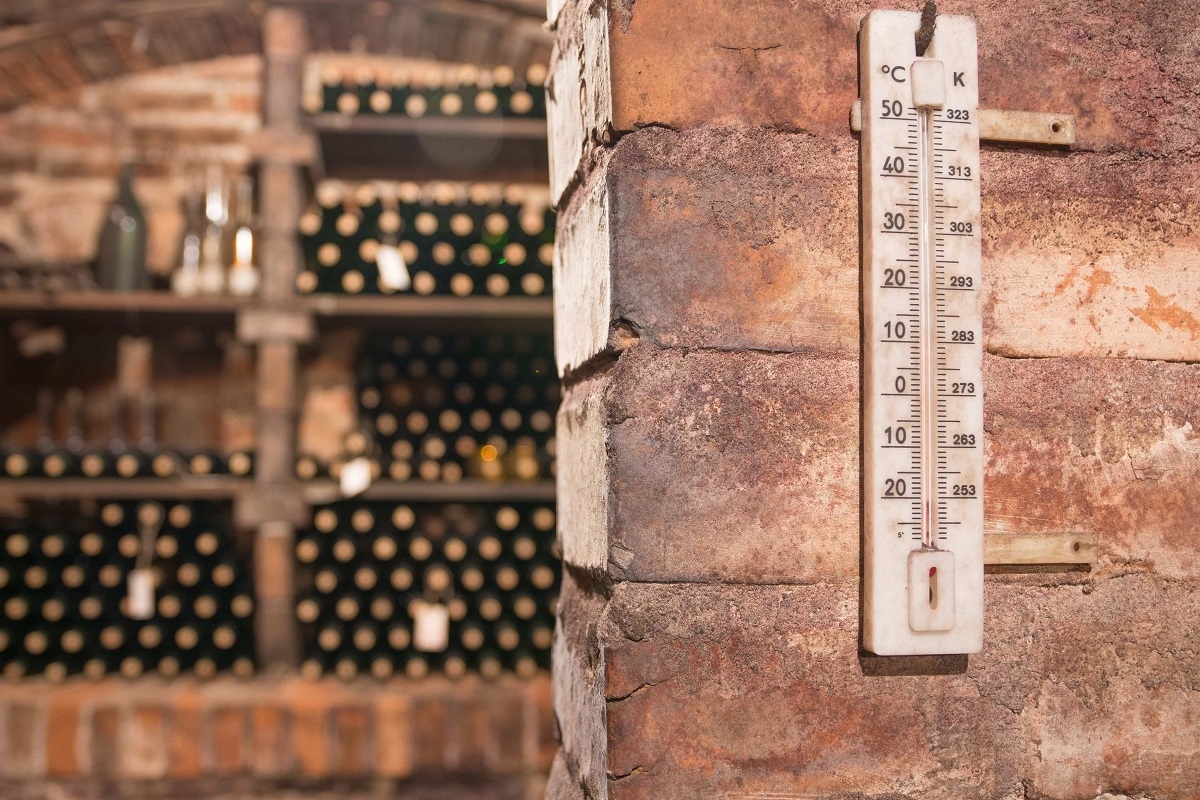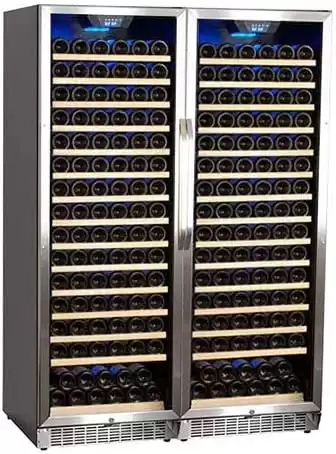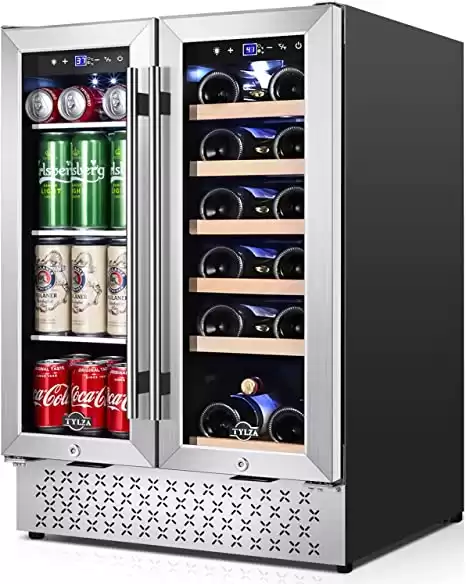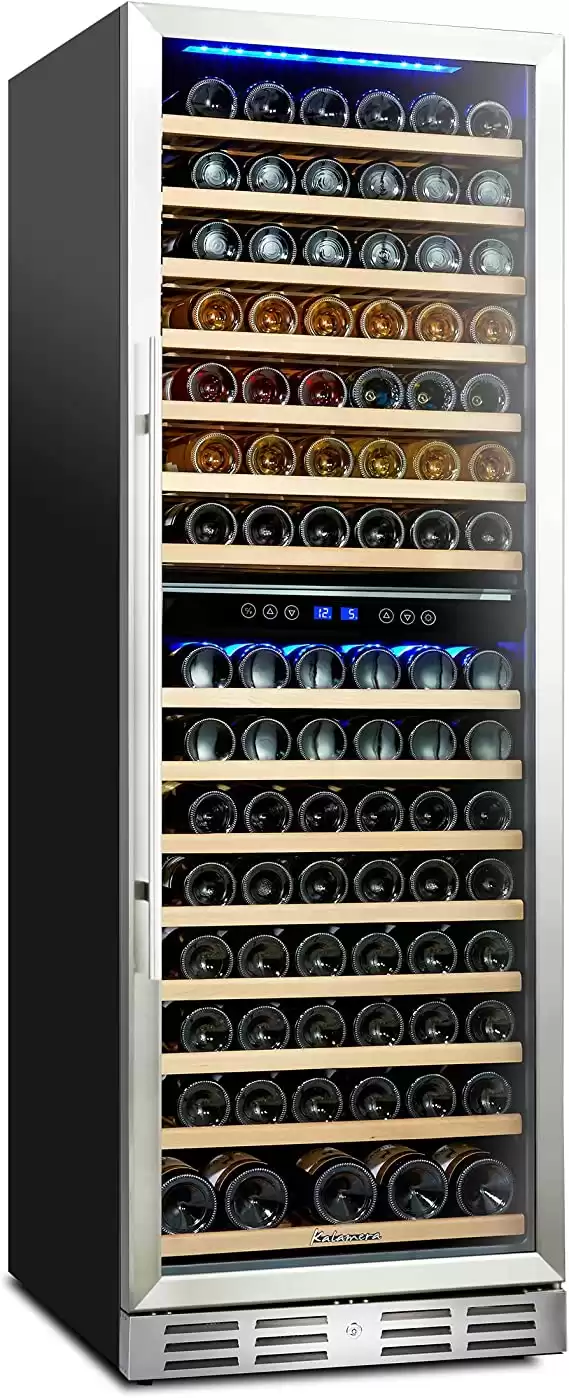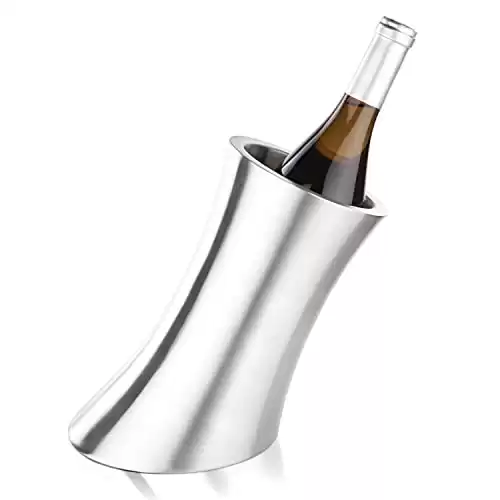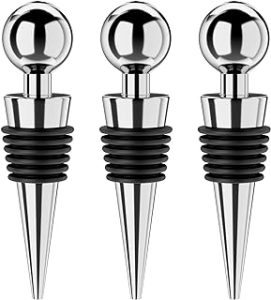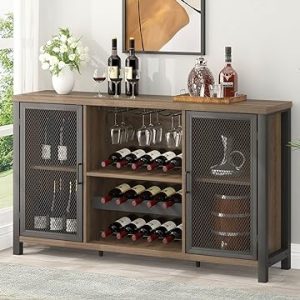This article will take you through all you need to know about the best temperature to store wine, along with a temperature chart to compare different wines.
quick picks
- Best Large Wine Refrigerator | TYLZA Wine Cooler
- Best Wine Rack | Ultra Wine Rack
- Best Mini Wine Fridge | Phiestina Wine Fridge
- Best Dual Zone Wine Refrigerator | NewAir Premier
- Best Wine Bottle Chiller | Maxso Wine Chiller
the best wine storage temperature (wine temperature chart)
There’s nothing like opening a bottle of your favorite wine to close off a tough week or to celebrate a happy occasion. Whether you prefer a red, white, or rosé, when you’re having a drink you want to make sure that you’re getting the most out of your wine.
One of the most important aspects of a good wine is how it’s stored – more specifically, the temperature that you keep the wine at when you’re storing it. Storing your wine properly is crucial, but with so many different wines it can be hard to know what you’re supposed to do.
That’s why we’ve done the hard part for you, and gathered all the information you need to know about proper wine storage temperatures into one handy article.
In this helpful guide, we’ll take you through everything there is to know about what temperatures to keep your wine stored in, how these temperatures can differ depending on what type of wine you have, as well as why temperature is so important in the first place. We’ve also included a small FAQ section to cover any burning questions you might have about your wine storage, as well as a nifty temperature chart to keep everything in order. So without further ado, let’s get right into it!
why is storage temperature important anyway?
When it comes to storing your wine, the temperature matters for several reasons. Keeping your wine at the right temperature will ensure it lasts longer without going bad, prevents it from becoming too hot or too cold (which can seriously harm the wine), and maintains the overall quality of the wine you’re storing.
The optimum storage temperature differs for each kind of wine, ranging anywhere from a refrigerated chill to just under room temperature. Even small changes to the temperature of your wine can have a knock-on effect in the future, so keeping it at a consistent and appropriate heat will make sure that your wine stays top quality.
There are a couple of consequences for storing your wine at the wrong temperature. Along with turning the wine bad over time, storing your wine at too low or too high a temperature brings risks like fostering bacteria, reducing the wine’s potency, and producing more bitter tannins.
If the wine is left to get too cold and freezes, it expands and creates a new set of issues; freezing damages the wine itself, while the expanding liquid can cause the cork to be pushed out or break (which lets oxygen get at the wine) and even shatter the entire bottle.
Storing your wine at the right temperature prevents these issues from occurring in the first place, while making sure that the temperature is controlled and your wine is kept in an appropriate environment will keep it at its best for the longest time possible. Not every wine needs the same conditions, however, and it’s important to know the right storage temperature for each variety of wine.
What temperature should i store my wine?
 As mentioned before, the right storage temperature for your wine depends on what type of wine it is. Luckily, there are a few basic rules for wine storage that can give you a good idea of what temperature to store your wine at.
As mentioned before, the right storage temperature for your wine depends on what type of wine it is. Luckily, there are a few basic rules for wine storage that can give you a good idea of what temperature to store your wine at.
Just like you’re meant to serve a red wine at room temperature, and white wines and rosés chilled, you’ll need to keep your lighter wines stored in a cooler location than red wines.
In general, the lighter the wine is, the colder you need to keep it. Darker reds can be kept in warmer storage than rosés, whites, and sparkling wines, with the optimum temperature decreasing as the wines become paler. Here’s a breakdown of what temperatures you should keep each type of wine at for the best results.
Red Wines
Red wines are split into several categories depending on how dark they are, which is mostly influenced by their age and strength. The strongest, darkest wines are referred to as ‘full-bodied’, which reflects their bold flavors and higher alcohol content.
Other lighter red wines fall into one of two other categories; light reds are much paler than full-bodied reds, with a lower alcohol content and more subtle flavors, while medium reds are a nice in-between. These wines don’t just look and taste different – they may all be red wines, but they need to be kept at separate temperatures.
Full-Bodied reds
 Full-bodied reds can be kept at the highest temperatures, only a few degrees below room temperature. Some of the most common full-bodied reds include Cabernet Sauvignon, Malbec, and Burgundy; these three popular reds are best stored at around 63℉ (17℃).
Full-bodied reds can be kept at the highest temperatures, only a few degrees below room temperature. Some of the most common full-bodied reds include Cabernet Sauvignon, Malbec, and Burgundy; these three popular reds are best stored at around 63℉ (17℃).
Darker full-bodied reds, such as Bordeaux and Shiraz, can be kept at slightly warmer temperatures of around 64℉ (18℃). The darkest, strongest red wines (e.g. Port and Madeira) are best stored at 66℉ (19℃), the highest storage temperature for any kind of wine.
Light and medium reds
There isn’t really much of a difference between the storage temperatures for light and medium red wines, and most of them only differ by a few degrees. Lighter reds need to be kept at lower temperatures between the 55-60℉ range. Medium red wines such as Merlot and Sherry should be stored from 57℉ (14℃) up to 60℉ (16℃) depending on their strength. The lightest red wines like Lambrusco and Pinot Noir need even lower temperatures, preferably around 56℉ (13℃).
rose wines
A rosé is a nice middle-ground between the bold, mature flavors of a red wine and the light sweetness of a white wine. In the same way, their ideal storage temperature straddles the line between the warmer temperatures preferred by red wines and the chillier storage required for white wines.
The same basic principle for red wines (and wine in general) applies here – the darker the rosé, the colder it needs to be stored. This is usually spread between the range of 55℉ (12℃) for darker rosés and 50℉ (10℃) for the lighter ones.
This isn’t much of a difference, and if you aren’t certain about where your rosé falls on the spectrum then you don’t need to worry about a few degrees unless you’re talking about long-term storage. Pinot Nero Rosé and Grenache Rosé are lighter rosés and should be kept at 51/52℉ (11℃), while darker rosés like Syrah Rosé and White Zinfandel need to be stored at 54/55℉ (12/13℃).
white wines
 Much like red wines, white wines are also broken down into separate categories. However, instead of their color, white wines are mostly judged by their dryness and their sweetness. Dry white wines have had most (more than 99%) of their residual sugar removed after fermentation, leaving them with a drier mouth-feel and a more refined flavor.
Much like red wines, white wines are also broken down into separate categories. However, instead of their color, white wines are mostly judged by their dryness and their sweetness. Dry white wines have had most (more than 99%) of their residual sugar removed after fermentation, leaving them with a drier mouth-feel and a more refined flavor.
Sweet white wines, meanwhile, have more of their residual sugar left and tend to be fruitier and (as their name suggests) sweeter. White wines need to be stored in a cooler environment than red wines and rosés, with their optimum temperature range lying between 45℉ (7℃) and 55℉ (12℃).
dry wines
Dry white wines are kept in warmer storage than their sweeter counterparts, but still need to be kept chilled. Some of the most common types of dry white include Chardonnay, Sauvignon Blanc, and Pinot Gris. Sauvignon Blanc and Pinot Gris are kept cooler, around 47℉ (8℃), while Chardonnay is at the higher end of the scale and needs to be stored at around 53℉ (11℃).
sweet wines
These are kept even cooler than dry white wines, mostly being stored in the 45-50℉ (7-10℃) range. Most sweet whites fall on the lower end of this, with wines such as Pinot Grigio being best suited to 45℉ (7℃), and others like Moscato and Sake even falling into the 42/43℉ (5/6℃) range.
sparkling wines
Sparkling wines need to be kept the coldest, with most varieties needing to be stored between 40-45 °F (5-7℃). Sparkling wines are typically white, but you can also find some sparkling rosé wines that are kept in slightly warmer temperatures. Some of the most common sparkling wines include Muscato and Prosecco (kept at 42℉ (6℃)), as well as Riesling and – most notably of all – Champagne (which are stored at 44℉ (7℃)).
wine storage temperature chart
So there you have it – the best temperatures to store each type of wine. It’s a lot to take in at once, so don’t worry. To help make it easier to manage, here’s a handy table with the appropriate storage temperatures for every variety of wine (including some examples)!
| Type Of Wine | Storage Temperature (℉) | Storage Temperature (℃) |
| Red | 55-65 | 12-19 |
| Full-Bodied Reds (Cabernet Sauvignon, Shiraz, Bordeaux, Port, etc.) | 60-65 | 16-19 |
| Light and Medium Reds (Pinot Noir, Merlot, Lambrusco, Sherry, etc.) | 55-60 | 12-16 |
| Rosé (White Zinfandel, Syrah Rosé, Pinot Nero Rosé, Grenache Rosé, etc.) | 50-55 | 10-12 |
| White | 45-55 | 7-12 |
| Dry Whites (Chardonnay, Sauvignon Blanc, Pinot Gris, etc.) | 50-55 | 10-12 |
| Sweet Whites (Pinot Grigio, Moscato, Sake, etc.) | 45-50 | 7-10 |
| Sparkling Wine (Champagne, Prosecco, Riesling, Muscat Blanc, etc) | 40-45 | 5-7 |
faqs about wine storage temperatures
At home wine storage recommendations:
Dual-zone wine coolers are perfect for those who love to entertain friends or family members. Different models can have between 2 and 4 different zones that can be set to different temperatures, depending on the beverage stored inside. These coolers are fantastic for people who have a wine collection that features red, white, and other beverages such as champagne.
Mini wine fridges are great for people who love drinking wine but don’t have much storage space for it. In fact, some of these small refrigerators can hold up to six 750ml bottles of wine. And, since most of them are designed as stand-alone units, they can be placed almost anywhere in the house.
The best large wine refrigerators are designed with the needs and preferences of wine lovers in mind. They should not only provide ample space for storing bottles but also offer easy access to them.
Stop stashing your wine bottles on a countertop, in a messy cabinet, or in a closet. Stop wasting your time scouring the internet for thousands of concepts and ideas. We created a buyer’s guide to purchasing the perfect wall mounted wine rack for you!
You need a better solution than storing your wine in a refrigerator or ice cooler in between pours and sips. That’s far too inconvenient. Thankfully there are some incredibly creative products that allow you to keep your wine bottle conveniently placed with a beautiful display. We will recommend our top picks, showcase wine chillers from marble, metals, and give you some great wine bucket options for your next dinner party.
where should i store my wine?
Wine is best stored in a cool, dark, and humid area – there’s a reason why it is traditionally kept in a cellar! Most people don’t have a wine cellar to spare, however, so you’ll need to find a suitable environment elsewhere. For wines with a higher storage temperature (mostly light- to full-bodied reds), you can get away with a kitchen cupboard, as these will stay cool and dark.
White wines, sweet wines, and sparkling wines need to be chilled more and are a bit harder to deal with as a result. A refrigerator will work fine for short-term storage, but ideally no more than a few days.
Some good alternatives to a wine cellar include under-stairs cupboards, a garage, or any other temperature-controlled storage you have. If you’re keeping your wine in the garage, there are a couple of things you should bear in mind; vibrations and strong smells can both negatively affect your wine, so keep the bottles well-insulated to protect your wine.
Wine fridges are also an option if you’re willing to splash out, with separate storage for different wines and a temperature-controlled fridge section (see also ‘Best Built In Wine Fridge‘).
does chilled wine last longer?
This mostly depends on the type of wine you’re storing. While some types of wine benefit from being stored in a cool place, low temperatures can actually be harmful to others.
On top of that, even wines that require chilling will be impacted if they become too cold; not only can their flavor and consistency be affected, but if the wine freezes then it will expand, risking pushing the cork out and oxidizing the wine, or even shattering the bottle entirely.
This is only an issue if the wine is stored at too low a temperature, and making sure that it is kept in a regulated environment will keep it at its best. If you’re storing your wine long-term, then you can extend its life by keeping it on the cooler side (only a degree or two lower); otherwise, you’ll be better off sticking to the recommended temperatures.
can you store different types of wine at the same temperature?
If you’re pushed for space and don’t have enough room to store your different varieties of wine separately, don’t worry. The temperature difference between most types of wine isn’t significant enough to cause any major issues if you keep them at a reasonable middle-ground, and you’re unlikely to ruin a bottle with the difference of a few degrees.
Using the right storage temperatures is important and your wine may suffer if you don’t, but it isn’t precarious enough that short-term storage of different wines with reasonably similar storage temperatures will lead to bad wine.
With that said, you should avoid storing wines with optimum temperatures that are too different where possible, and aim for wines that only have a couple of degrees difference. For wines with drastically different storage temperatures – for instance, Champagne (43℉) and Cabernet Sauvignon (63℉) – you’ll need to find alternative storage spaces to suit their needs. If in doubt, aim for around 55℉ for a good middle-ground for most wines.
final thoughts
Now you know everything there is to know about the proper wine storage temperatures! Keeping your wine stored in the correct environment is crucial for making sure that you get the most out of your bottle; so make sure that your wine is at the right temperature so you can get the best out of every drop!
Every wine is different, but with this handy guide you’ll be able to keep track of what temperature you need for your wine.
So if you’re struggling to remember the difference between a Merlot and a Muscato or a Shiraz and a Sake, you can count on this guide and the helpful chart to keep you covered!

